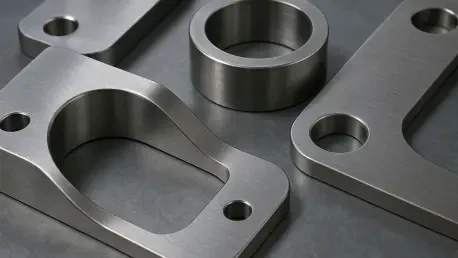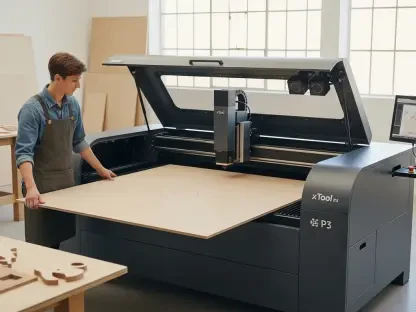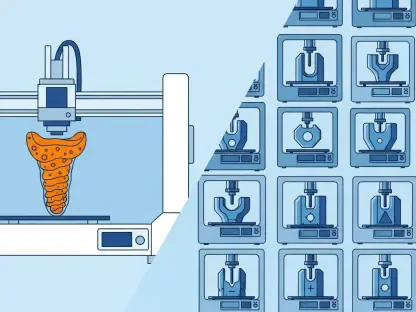In a remarkable advancement for materials science, engineers at the Royal Melbourne Institute of Technology (RMIT) in Australia have introduced a pioneering 3D-printed titanium alloy that stands to revolutionize industries such as aerospace and medical devices. This cutting-edge material not only surpasses traditional titanium alloys in strength and durability but also slashes production costs by nearly 29%, offering a compelling solution to long-standing challenges in additive manufacturing. The breakthrough addresses critical barriers like high expenses and inconsistent mechanical properties that have hindered the broader adoption of 3D printing in high-stakes sectors. By reimagining the potential of titanium alloys, RMIT’s innovation could pave the way for more accessible and efficient manufacturing processes. The significance of this development extends beyond a single material, as it challenges conventional approaches and sets a new benchmark for what additive manufacturing can achieve in demanding applications.
Breaking Barriers with Cost Efficiency
The RMIT team, spearheaded by PhD candidate Ryan Brooke and Professor Mark Easton, has achieved a significant reduction in production costs by replacing costly elements like vanadium with more affordable and readily available alternatives. This strategic substitution has resulted in an alloy that is approximately 29% cheaper to produce than the industry-standard Ti-6Al-4V, which has long been a staple in titanium applications. Cost has historically been a major obstacle to the widespread use of 3D-printed titanium, often relegating it to niche or high-budget projects despite its desirable properties. By tackling this financial hurdle, the new alloy opens doors for industries where tight budgets have previously limited the adoption of advanced materials. This cost-effective approach does not compromise on quality, positioning the material as a viable option for manufacturers seeking to balance performance with economic feasibility in sectors that demand precision and reliability.
Moreover, the implications of this cost reduction extend far beyond immediate savings, as it aligns with a broader industry trend of democratizing access to cutting-edge technologies. The affordability of the alloy could encourage smaller companies and startups to explore 3D printing for complex applications, fostering innovation across a wider range of businesses. In fields like aerospace, where lightweight yet strong materials are critical, and in medical device manufacturing, where biocompatibility is key, such a price drop could lead to more experimentation and faster development cycles. The RMIT team’s focus on accessible materials highlights a shift toward inclusive manufacturing solutions that prioritize scalability. This development serves as a catalyst for rethinking how cost barriers can be dismantled without sacrificing the high standards required in critical applications, potentially reshaping market dynamics for titanium-based products.
Elevating Performance Standards
One of the standout features of RMIT’s new titanium alloy is its superior mechanical performance, surpassing conventional 3D-printed titanium in both strength and ductility. A major challenge in additive manufacturing has been the formation of columnar microstructures, which often result in inconsistent properties and compromise reliability. The innovative design of this alloy prevents such issues by ensuring a uniform grain structure, leading to consistent and dependable performance under stress. This advancement is particularly crucial for industries where safety and precision are paramount, such as aerospace components that must withstand extreme conditions or medical implants that require flawless integration with the human body. The enhanced properties of the alloy mark a significant step forward in addressing the limitations that have long plagued 3D-printed metals.
Additionally, the improved performance of this material underscores its potential to meet the rigorous demands of real-world applications. Rigorous testing conducted at RMIT’s facilities has validated the alloy’s capabilities, demonstrating its ability to outperform traditional options like Ti-6Al-4V in critical metrics. This reliability could translate into longer-lasting components, reducing the need for frequent replacements and maintenance in high-stakes environments. For manufacturers, this means not only better products but also potential cost savings over time due to increased durability. The alloy’s ability to maintain consistent quality across production batches further enhances its appeal, as it minimizes the risk of defects that could lead to failures. By setting a new standard for strength and uniformity, RMIT’s creation offers a glimpse into a future where 3D-printed materials rival or even exceed the performance of conventionally manufactured counterparts.
Innovating the Future of 3D Printing
Rather than merely refining existing materials, the RMIT researchers have developed an entirely new framework for designing alloys tailored specifically for 3D printing, unlocking the full potential of additive manufacturing. Traditional alloys like Ti-6Al-4V, while effective in conventional methods, often fail to capitalize on the unique advantages of 3D printing, such as rapid production, customization, and minimal waste. This novel approach rethinks alloy composition to align with the specific demands of additive processes, ensuring optimal results. The significance of this framework lies in its transformative mindset, pushing beyond incremental improvements to redefine what is possible in material science. It represents a bold step toward harnessing the speed and flexibility of 3D printing for complex, high-performance applications across various industries.
Furthermore, this innovative design philosophy could inspire a wave of advancements in additive manufacturing, encouraging other researchers and companies to explore tailored materials for specific technologies. The framework’s emphasis on customization means that future alloys could be developed to meet highly specialized needs, from extreme temperature resistance in space exploration to enhanced biocompatibility for medical prosthetics. By aligning material properties with the unique capabilities of 3D printing, RMIT’s approach maximizes efficiency and reduces the limitations that have historically constrained the technology’s adoption. This shift in perspective could accelerate the integration of additive manufacturing into mainstream production, particularly in sectors that have been slow to embrace it due to material constraints. The groundwork laid by this project signals a turning point, where 3D printing evolves from a niche tool to a cornerstone of industrial innovation.
Forging Partnerships for Market Readiness
To transition this groundbreaking alloy from laboratory success to commercial reality, RMIT is actively pursuing collaborations with industry partners across the supply chain. With samples already produced and rigorously tested at the Advanced Manufacturing Precinct, and a provisional patent secured for their unique approach, the project stands at a critical juncture. Engaging with manufacturers, suppliers, and end-users is essential to refine the material for specific applications and ensure it meets industry standards. Such partnerships will play a pivotal role in scaling production and addressing practical challenges that may arise during implementation. The collaborative effort is particularly vital for sectors like aerospace and healthcare, where the alloy’s properties could have a profound impact, provided it is tailored to real-world demands through shared expertise.
In addition, the push for industry involvement reflects an understanding that academic innovation alone cannot bridge the gap to widespread adoption. Input from stakeholders who understand market needs and operational constraints will help shape the alloy’s final form, ensuring it aligns with production capabilities and regulatory requirements. This stage of development also offers an opportunity to gather feedback on potential applications, from aircraft components to surgical implants, further honing the material’s versatility. The RMIT team’s proactive outreach to potential partners demonstrates a commitment to practical impact, recognizing that successful commercialization requires a collective effort. As these collaborations take shape, they could expedite the alloy’s journey to market, positioning it as a cornerstone of future manufacturing solutions in industries hungry for cost-effective, high-performance materials.
Envisioning a Global Materials Revolution
RMIT’s development of this titanium alloy aligns seamlessly with a worldwide movement to overcome material limitations in additive manufacturing, reflecting a shared vision for cost-effective and high-performance solutions. Parallel initiatives, such as AI-driven alloy enhancements at Johns Hopkins University, highlight a collective drive to push the boundaries of titanium applications across diverse fields like deep-sea exploration and space travel. This convergence of efforts suggests that the industry is on the cusp of a materials revolution, where advanced technologies and innovative thinking redefine manufacturing possibilities. RMIT’s contribution serves as a vital piece of this larger puzzle, demonstrating how localized breakthroughs can resonate on a global scale and inspire further advancements in the quest for superior materials.
Moreover, the broader implications of this trend point to a future where tailored materials become the norm rather than the exception, fundamentally altering how industries approach production. The focus on overcoming cost and performance barriers in 3D printing could lead to more sustainable practices, as additive manufacturing inherently reduces waste compared to traditional methods. As global research continues to evolve, the synergy between projects like RMIT’s and other cutting-edge studies could accelerate the development of next-generation materials suited for an array of emerging technologies. This collective momentum underscores the importance of innovation in addressing modern manufacturing challenges, setting the stage for a landscape where advanced alloys enable unprecedented achievements. RMIT’s work, in this context, not only solves immediate problems but also contributes to a visionary shift in how materials science shapes industrial progress.









